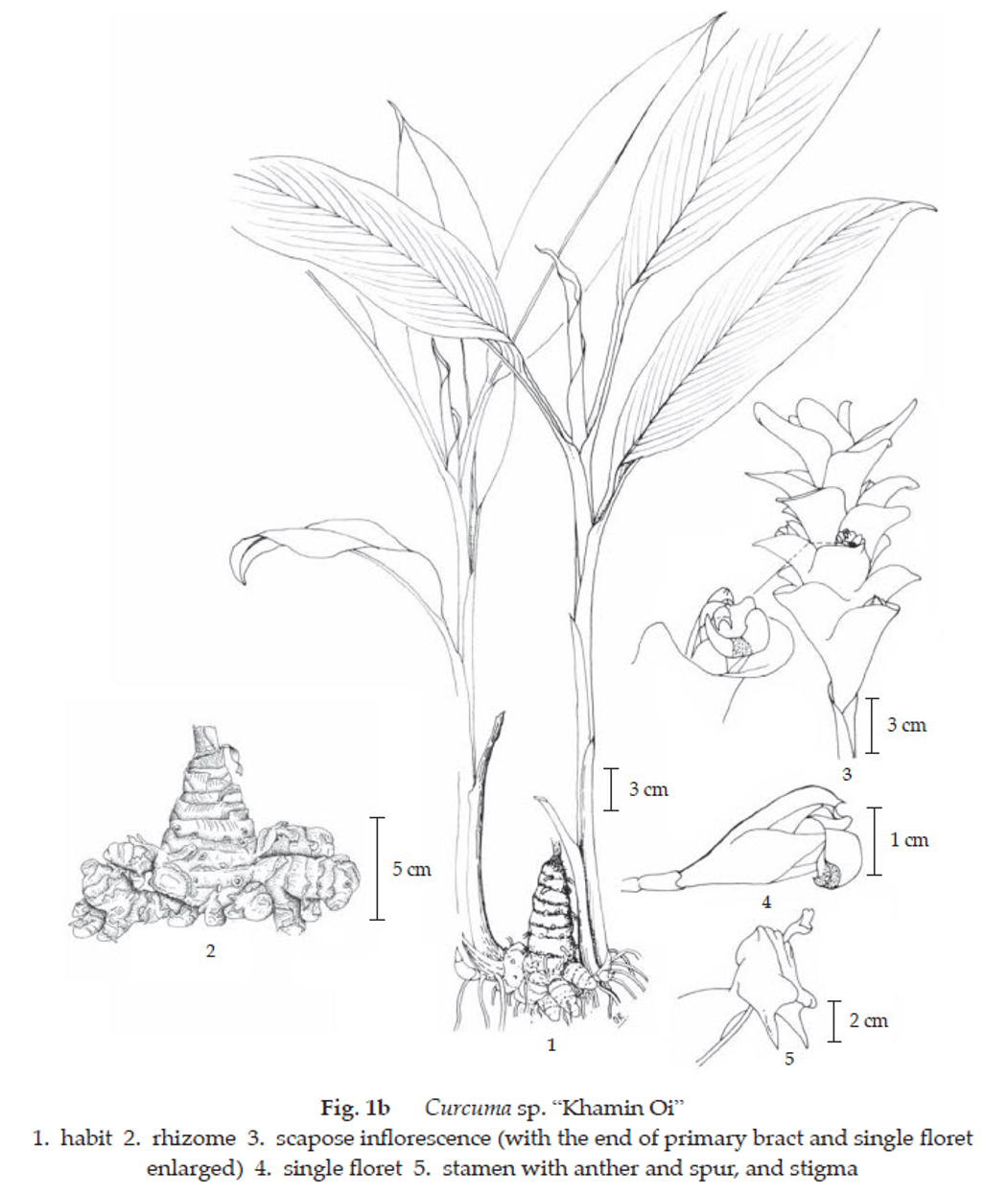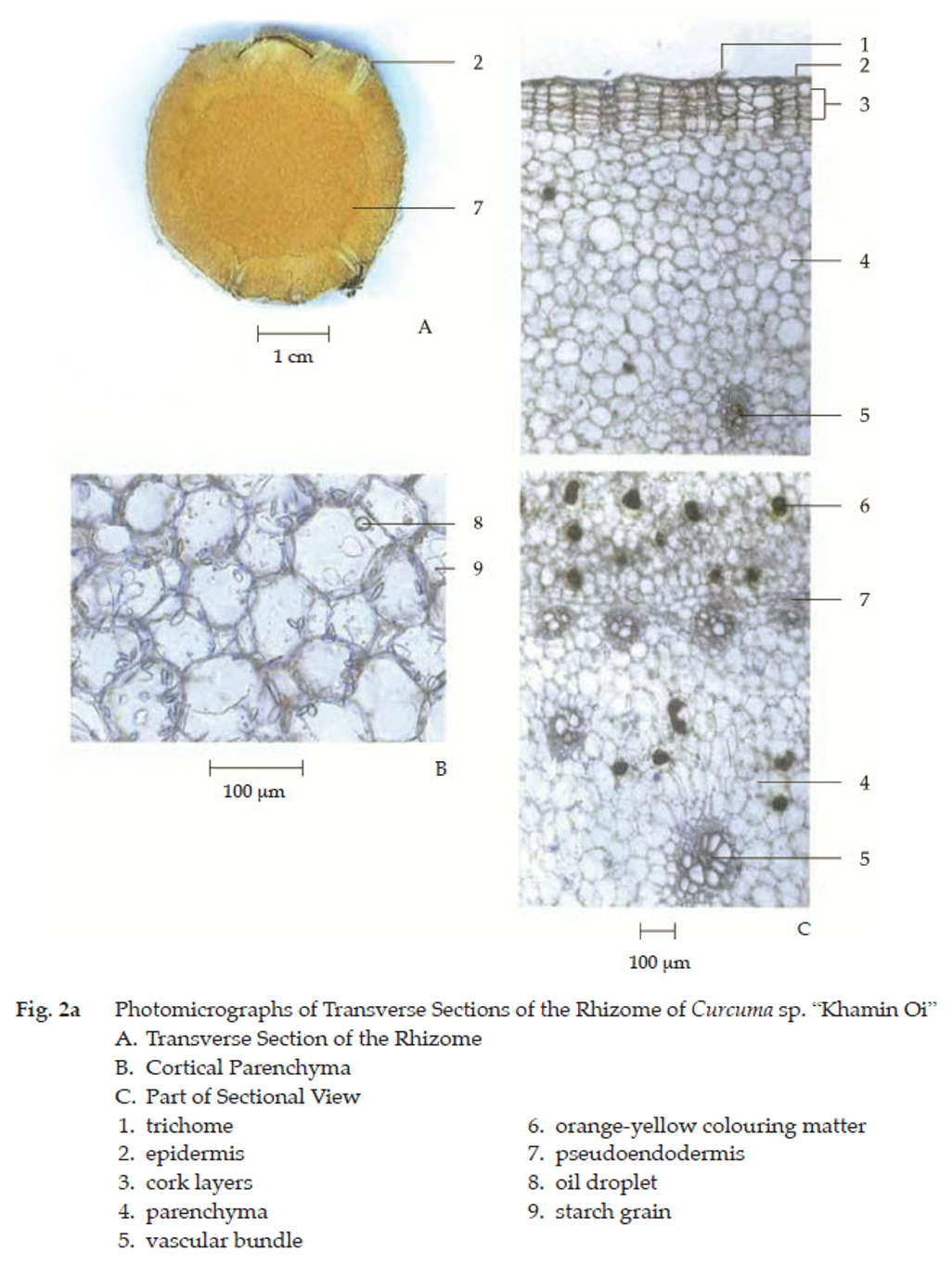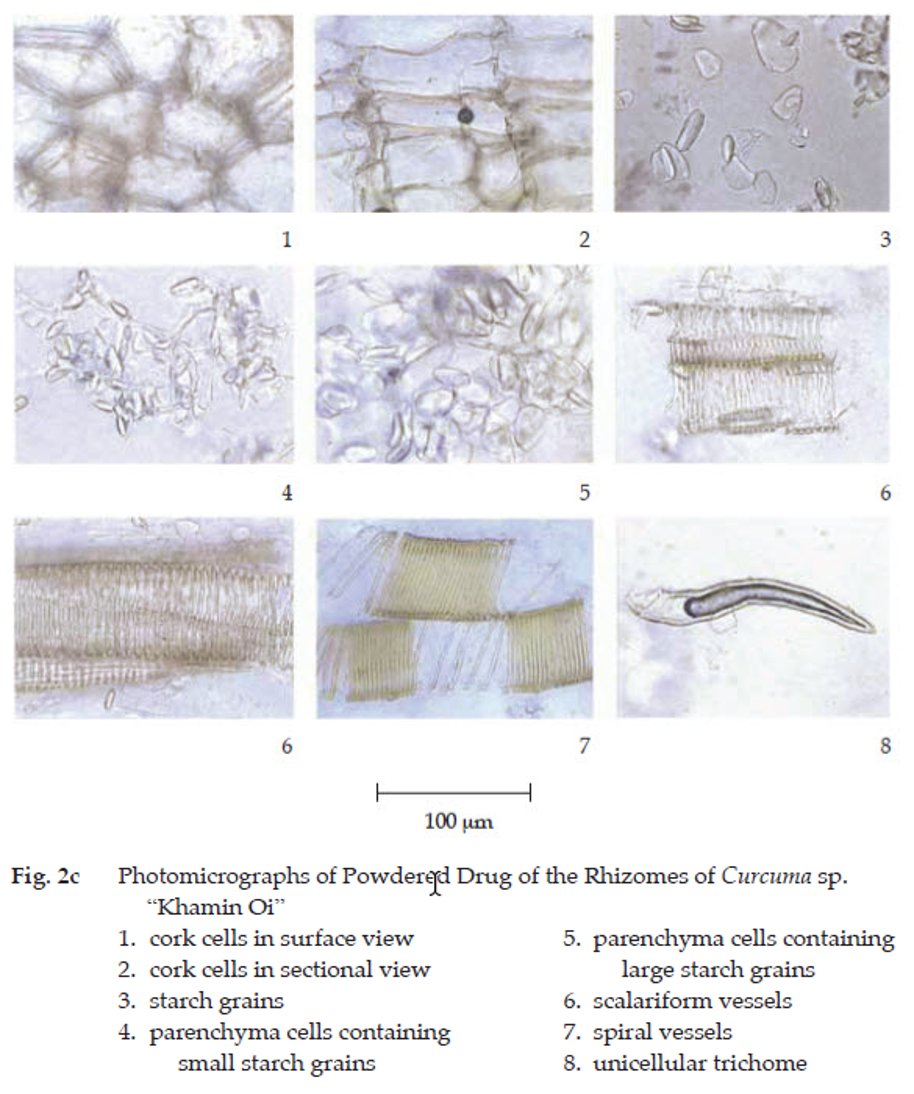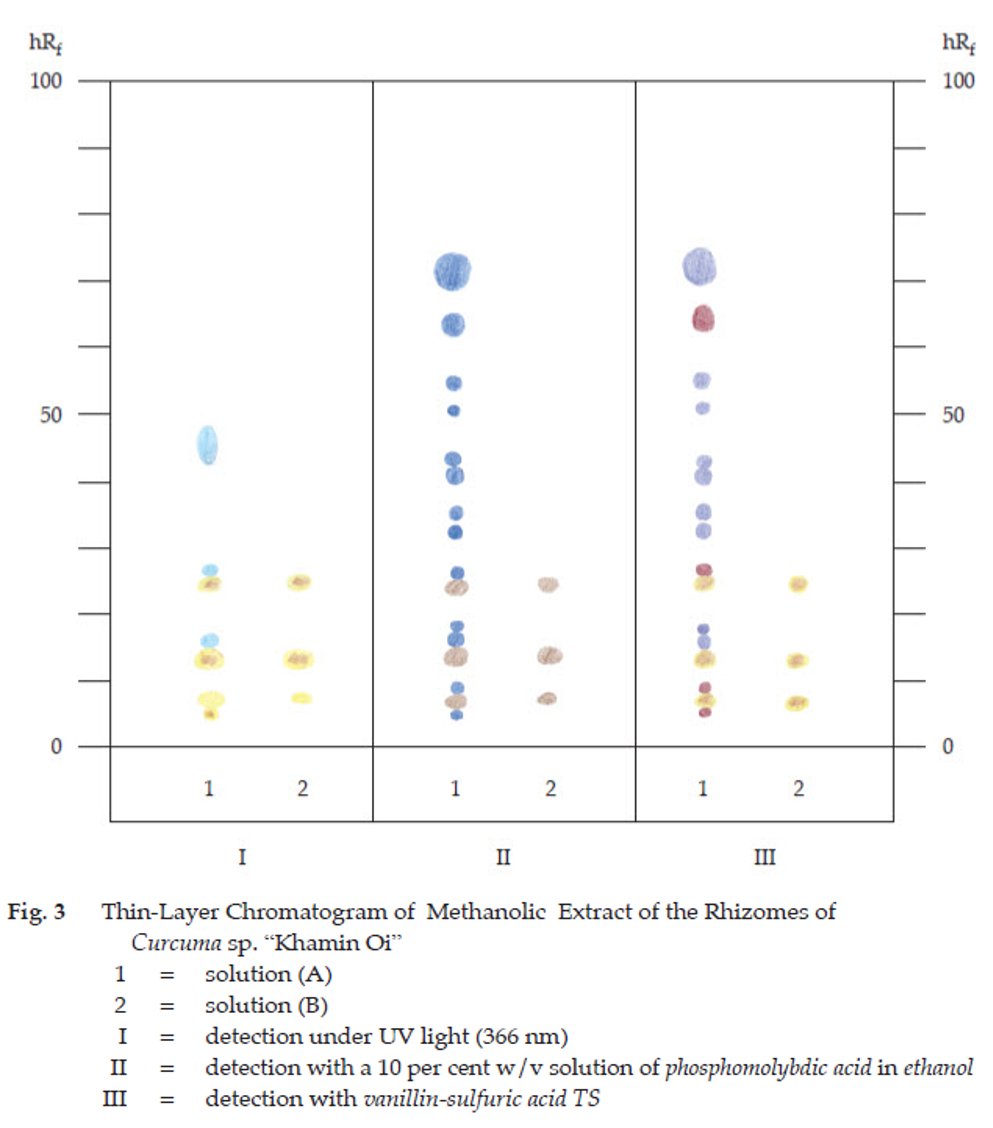ตำรามาตรฐานยาสมุนไพรไทย
Thai Herbal Pharmacopoeia
สำนักยาและวัตถุเสพติด กรมวิทยาศาสตร์การแพทย์ กระทรวงสาธารณสุข
Bureau of Drug and Narcotic, Department of Medical Sciences, Ministry of Public Health(Tinospora crispa (L.) Hook.f. & Thomson)
(Nelumbo nucifera Gaertn.)
(Centella asiatica (L.) Urb.)
(Centella Dry Extract)
(Centella Cream)
(Mesua ferrea L.)
(Piper sarmentosum Roxb.)
(Piper sarmentosum Roxb.)
(Pterocarpus santalinus L. f.)
(Santalum album L.)
(Senna tora (L.) Roxb.)
(Senna alata (L.) Roxb.)
(Senna Alata Tea)
(Piper retrofractum Vahl)
(Myristica fragrans Houtt)
(Andrographis paniculata (Burm. f.) Nees)
(Andrographis Capsules)
(Allium ascalonicum L.)
(Ocimum tenuiflorum L.)
(Curcuma longa L.)
(Turmeric Capsules)
(Turmeric Dry Extract)
(Turmeric Dry Extract Capsules)
(Arcangelisia flava (L.) Merr.)
(Curcuma sp.)
Harrisonia perforata (Blanco) Merr.
(Aristolochia pierrei Lecomte)
(Zingiber officinale Roscoe)
(Ginger Capsules)
(Ginger Tea)
(Cassia fistula L.)
(Nardostachys jatamansi (D. Don) DC.)
(Angelica sinensis (Oliv.) Diels)
Artemisia annua L.
(Ligusticum sinense Oliv. cv. Chuanxiong)
(Neopicrorhiza scrophulariiflora Pennell)
(Atractylodes lancea (Thunb.) DC.)
(Aucklandia lappa Decne)
(Terminalia chebula Retz.)
(Angelica dahurica (Hoffm.) Benth. & Hook. f. ex Franch. & Sav. var. dahurica)
(Kaempferia parviflora Wall. ex Baker)
(Hibiscus sabdariffa L.)
(Roselle Tea)
(Allium sativum L.)
(Zingiber zerumbet (L.) Sm.)
(Wurfbainia testacea (Ridl.) Škorničk.& A. D. Poulsen)
(Cannabis sativa L.)
(Myristica fragrans Houtt)
(Dracaena cochinchinensis (Lour.) S. C. Chen)
(Ficus racemosa L.)
(Hyptis suaveolens (L.) Poit.)
Clerodendrum indicum (L.) Kuntze
(Phyllanthus emblica L.)
(Citrus hystrix DC.)
(Citrus hystrix DC.)
(Areca catechu L.)
(Momordica charantia L.)
Moringa oleifera Lam.
(Aegle marmelos (L.) Corrêa)
(Solanum trilobatum L.)
(Morus alba L.)
Gynostemma pentaphyllum(Thunb.)
Makino
(Clinacanthus nutans (Burm. f.) Lindau)
(Cissus quadrangularis L.)
(Mimusops elengi L.)
(Zingiber montanum (J. König) Link. ex A. Dietr.)
(Piper betle L.)
(Capsicum annuum L.)
(Capsicum Oleoresin)
(Capsicum Gel)
(Piper nigrum L.)
(Piper nigrum L.)
(Eurycoma longifolia Jack)
(Thunbergia laurifolia Lindl.)
(Piper wallichii (Miq.) Hand.-Mazz.)
Senna garrettiana (Craib) H. S. Irwin & Barneby
(Terminalia bellirica (Gaertn.) Roxb.)
(Terminalia chebula Retz.)
(Caesalpinia bonduc (L.) H. Roxb.)
(Tarlmounia elliptica (DC.) H. Rob., S. C. Keeley, Skvaria & R. Chan)
(Hog Creeper Vine Dry Extract Capsiles)
(Hog Creeper Vine Dry Extract)
(Brachypterum scandens (Roxb.) Miq.)
(Lepidium sativum L.)
(Nigella sativa L.)
(Cuminum cyminum L.)
(Foeniculum vulgare Mill.)
(Plantago ovata Forssk.)
(Pimpinella anisum L.)
(Carum carvi L.)
(Anethum graveolens L.)
(Trachyspermum ammi (L.) Sprague)
Albizia procera (Roxb.) Benth.
(Acorus calamus L.)
(Tiliacora triandra (Colebr.) Diels)
Cyanthillium cinereum (L.) H. Rob.
(Orthosiphon aristatus (Blume) Miq.)
Murdannia loriformis (Hassk.) R. S. Rao & Kammathy
(Capparis micracantha DC.)
(Chrysopogon zizanioides (L.) Roberty)
(Cyperus rotundus L.)
(Cannabis sativa L.)
(Syzygium aromaticum (L.) Merr. & L. M. Perry)
(Boesenbergia rotunda (L.) Mansf.)
(Acanthus ebracteatus Vahl)
(Acanthus ilicifolius L.)
(Kaempferia galanga L.)
(Curcuma comosa Roxb.)
Betula alnoides Buch.-Ham. ex D. Don
Cannabis sativa L.
Carthamus tinctorius L
Mitragyna speciosa (Korth.) Havil
Mallotus repandus (Rottler) Müll. Arg
Azadirachta indica A. Juss. var. siamensis Valeton
Azadirachta indica A. Juss. var. siamensis Valeton
Punica granatum L.
Rhinacanthus nasutus (L.) Kurz
Baliospermum solanifolium (Burm.) Suresh
Curcuma aeruginosa Roxb
Boesenbergia kingii Mood & L. M. Prince
Senegalia rugata (Lam.) Britton & Rose
Acacia concinna (Willd.) DC.
Senegalia rugata (Lam.) Britton & Rose
Acacia concinna (Willd.) DC.
Senna alexandriana Mill. var. alexandriana
Cassia acutifolia Delile, Cassia angustifolia Vahl
Butea superba Roxb. ex Willd.
[Plaso superba (Roxb. ex Willd.) Kuntze, Rudolphia superba (Roxb. ex Willd.) Poir.
Pueraria candollei Graham
ex Benth. var. mirifica (Airy Shaw & Suvat.) Niyomdham
Streblus asper Lour.
Suregada multiflora (A. Juss.) Baill. (Gelonium
multiflorum A. Juss.
Khamin Oi is the dried rhizome of Curcuma sp. “Khamin Oi” (Family Zingiberaceae), Crude Drug Number: DMSc 0271.
Constituents Khamin Oi contains curcuminoids, of which curcumin, desmethoxycurcumin, and bisdesmethoxycurcumin are its major components. It also contains volatile oil, etc.
Description of the plant (Figs. 1a, 1b) Perennial herb; rhizome well-developed, mostly above ground, obconical to oblong-ovoid, branched, orange-yellow or pale yellow within, aromatic; leafy shoots up to 2 m tall, bearing 4 to 9 leaves. Leaves simple, oblong-lanceolate, up to 90 cm long, up to 25 cm wide, apex acuminate, glabrous or pubescent, base acute decurrent; petioles long, narrowly winged. Inflorescence scape from the rhizome, appearing before the leaves; peduncle 5 to 15 cm long; spike cylindric, usually gradually widened to the apex, 10 to 18 cm long, 6 to 8 cm in diameter; primary bracts numerous, lower ones halfway connate, free part obliquely erect, 3 to 8 cm long, bracts usually increasing in length to the apex of spike, those of the lower bracts pale green or whitish, coma bract free and spreading, usually red-purple or violet; bracteoles hairy. Flower pale yellow; calyx hairy, tubular, white or white with red teeth; corolla about 4 cm long, tube white or yellowish, lobes ovate or oblong, white with pink; labellum orbicular or obovate, bilobed, yellow or white with yellow median field; petaloid staminodes oblong-obovate, pale yellow; ovary inferior, trilocular. Fruit capsule, ovoid, trigonous. Seeds oblong, arillate.
Description Odour, characteristic and aromatic; taste, slightly bitter and pungent.
Macroscopical (Fig. 1a) Dried slices of primary rhizomes and branched annulate tubers vary in size, shape and thickness; somewhat crooked, orange-yellowish brown to greyish brown; enclosed or nearly enclosed with outer cork layer, covered with coarse trichomes. Pseudoendodermal rings are seen in horizontal and oblique slices
Microscopical (Figs. 2a, 2b, 2c) Transverse section of the fresh rhizome shows epidermis, composed of a layer of rectangular cells; covering trichomes, unicellular and uniseriate multicellular. Storied cork, several layers of rectangular cork cells. Cortex, composed of broad zone of thin-walled parenchyma cells, filled with numerous starch grains, some of which containing brownish yellow oleoresin or yellowish oil droplets. Pseudoendodermis, a circular layer of compressed rectangular cells, enclosing a broad zone of parenchyma cells similar to those in cortex. Vascular bundles, not yielding the reaction with phloroglucinol TS, scattering densely underneath endodermis; vessels, spiral, scalariform and reticulate.
Khamin Oi in powder possesses the diagnostic microscopical characters of the unground drug.
Contra-indication It is contra-indicated in pregnant women





Packaging and storage Khamin Oi shall be kept in well-closed containers, preferably of metal or glass, protected from light and stored in a cool and dry place.
Identification
A. Extract 10 mg of the sample, in powder, with 2 ml of acetic anhydride, add a few drops of sulfuric acid and observe under ultraviolet light (366 nm): the solution shows blood-red colour.
B. Carry out the test as described in the “Thin-Layer Chromatography” (Appendix 3.1), using silica gel G as the coating substance and a mixture of 49 volumes of toluene, 49 volumes of chloroform and 2 volumes of absolute ethanol as the mobile phase and allowing the solvent front to ascend 17 cm above the line of application. Apply separately to the plate, 5 μL each of the following two solutions. Prepare solution (A) by placing 1 g of the sample, in powder, in a stoppered test-tube, adding 3 mL of methanol and shaking for a few minutes. Set aside for 1 hour and filter. For solution (B), dissolve 1 mg of curcumin in 1 mL of methanol. After removal of the plate, allow it to dry in air, and examine under ultraviolet light (366 nm), locating the spots. The chromatogram obtained from solution (A) shows several spots of different colours. Two orange-brown spots (hRf values 24 to 26 and 12 to 15) and one yellow spot (hRf value 6 to 8) correspond to the spots of curcumin and its derivatives from solution (B). Spray the plate with a 10 per cent w/v solution of phosphomolybdic acid in ethanol and heat at 105° for about 10 minutes; the spots due to curcumin and its derivatives are brown. Other spots are blue (Table 1); see also Fig. 3.
Repeat the same procedure on another plate but spray with vanillin-sulfuric acid TS and heat at 105° for about 10 minutes. The chromatogram obtained from solution (A) shows three orange-brown spots corresponding to the spots of curcumin and its derivatives from solution (B). Other spots are purple and violet (Table 1); see also Fig. 3.
Table 1 hRf Values of Component in Metanolic Extract of the Rhizomes of Curcuma sp. “Khamin Oi”
| Spot |
hRf Value |
Detection | ||
| UV 366 | 10 Per Cent W/V Solution of Phosphomolybdic Acid in Ethanol |
Vanillin-Sulfuric Acid TS | ||
|
1 |
4-6 6-8 8-10 12-15 15-18 18-19 24-26 26-28 32-35 35-38 41-44 44-46 44-51 52-54 56-59 65-69 72-78 |
orange-blue |
blue brown blue brown blue blue brown blue blue blue blue blue - blue blue blue blue |
purple orange-brown purple orange-brown violet violet orange-brown purple violet violet violet violet - violet violet purple violet |
*curcumin and its derivatives
Water Not more than 11.0 per cent v/w (Azeotropic Distillation Method, Appendix 4.12).
Acid-insoluble ash Not more than 6.0 per cent w/w (Appendix 7.6).
Sulfated ash Not more than 14.0 per cent w/w (Appendix 5.3).
Volatile oil Not less than 4.0 per cent v/w (Appendix 7.3H). Use 10 g, in fine powder, accurately weighed. Use 100 mL of water as the distillation liquid and a 500-mL round-bottomed flask. Distil at a rate of 2 to 3 mL per minute for 5 hours. Use 2.0 mL of xylene in the graduated tube. Calculate the content of volatile oil with reference to the anhydrous substance.
Dose 4.5 to 9 g.
